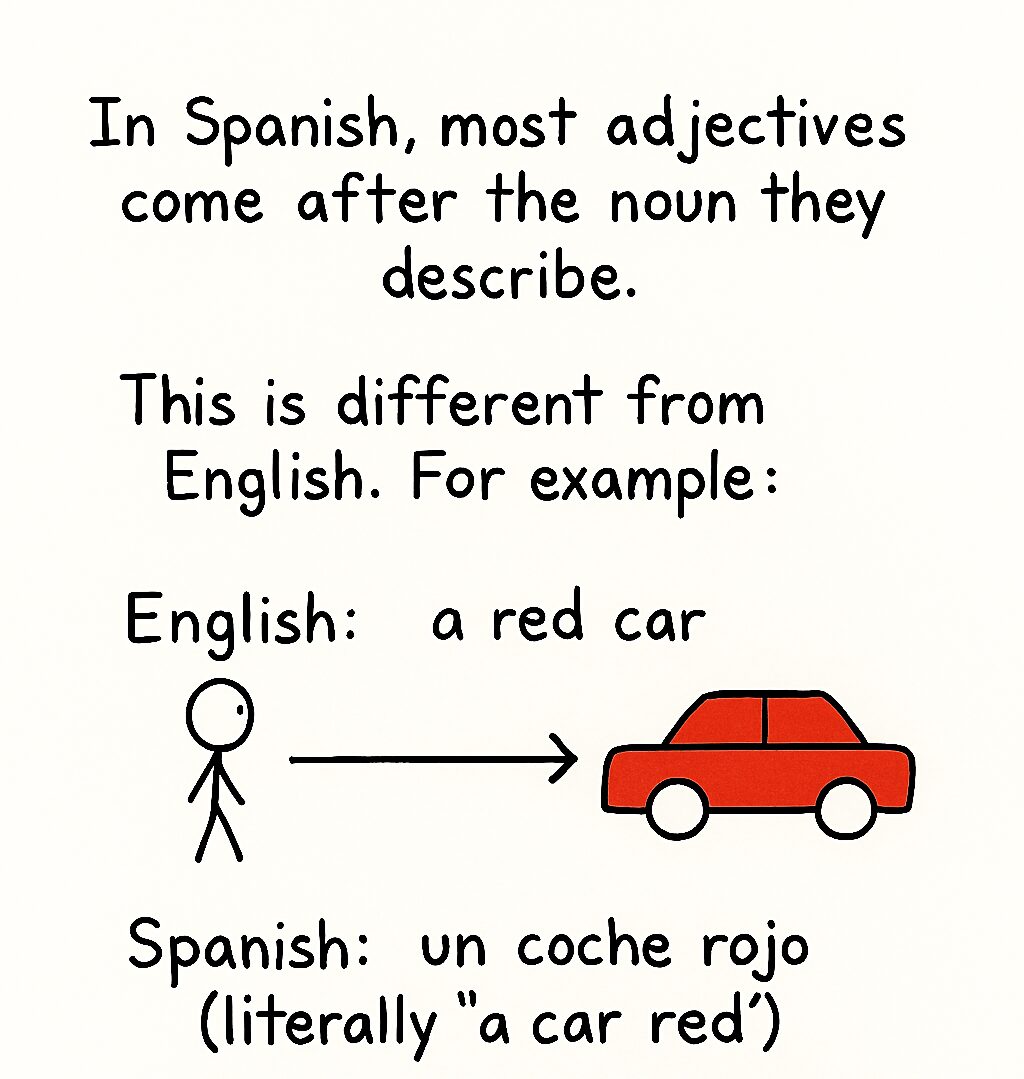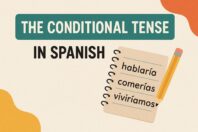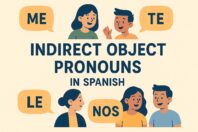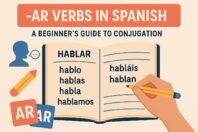Adjectives in Spanish: When and how to use them
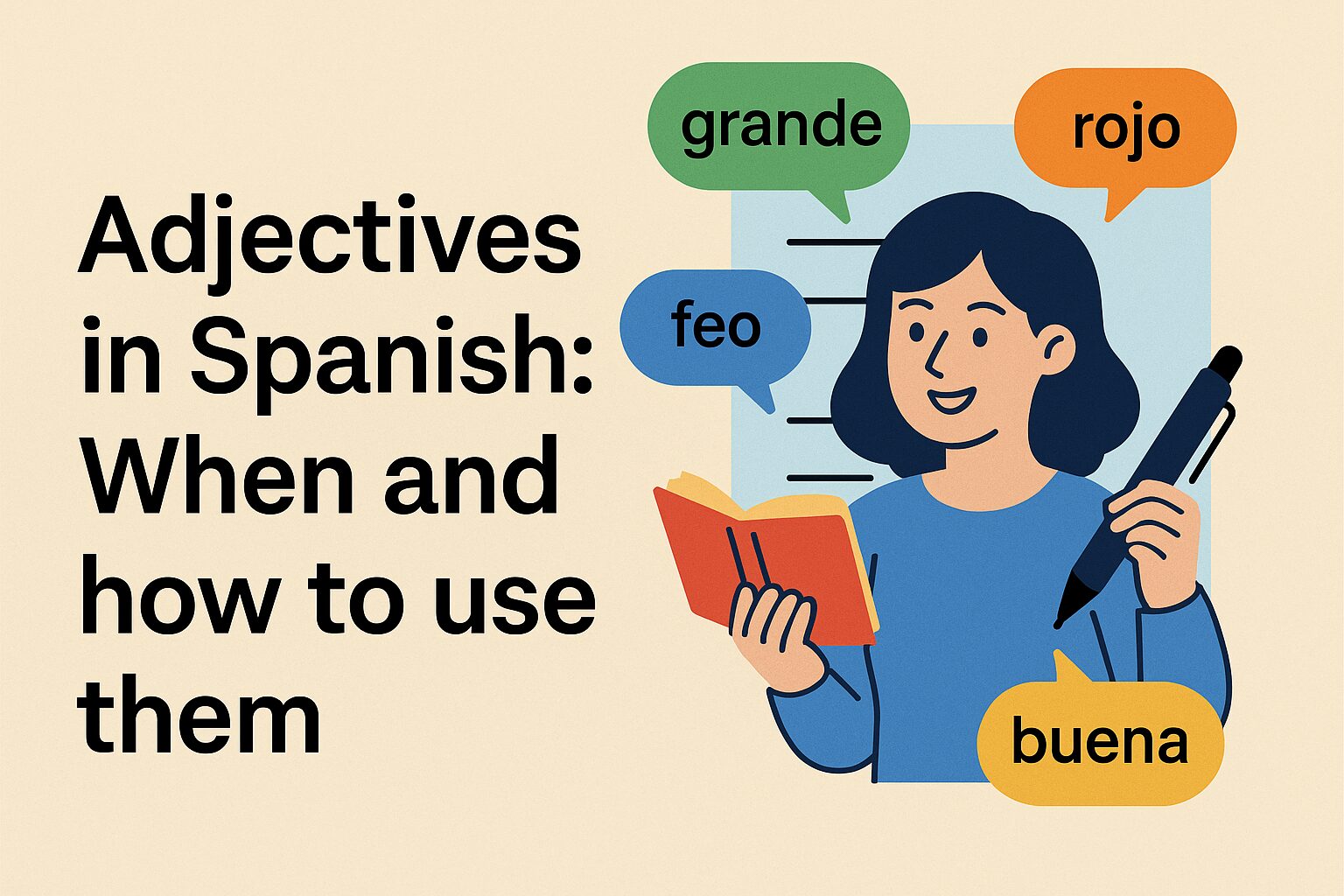
Get our free email course, Shortcut to Conversational.
Have conversations faster, understand people when they speak fast, and other tested tips to learn faster.
More infoAdjectives in Spanish describe a person, place, or thing just like in English. For example, in English, you might say “a small cat” – small is the adjective describing the cat. In Spanish, you’d say “un gato pequeño”, which literally is “a cat small.” Notice something different? In Spanish, the adjective usually comes after the noun, and Spanish adjectives have to match the noun they describe in gender. Don’t worry, we’ll explain all of this now. Let’s dive in!
What is an adjective in Spanish?
Adjectives (adjetivos) are words that describe or modify nouns.
They can tell us:
- What kind (a big house – casa grande)
- Which one (this book – este libro)
- How many (two dogs – dos perros)
- Whose (my friend – mi amigo)
In Spanish, most adjectives come after the noun they describe. This is different from English. For example:
- English: a red car
- Spanish: un coche rojo (literally “a car red”)
Both phrases mean the same thing, but Spanish puts “rojo” (red) after “coche” (car).
Also, Spanish adjectives change their form to match the noun’s gender and number.
If a noun is feminine, the adjective might end in -a; if the noun is masculine, the adjective might end in -o (for many adjectives).
And if the noun is plural, the adjective usually gets an -s at the end to make it plural too.
For example:
- niño alto → a tall boy
- niños altos → tall boys
- niña alta → a tall girl
- niñas altas → tall girls
Notice that alto changes to alta for the feminine noun, and an -s is added to make the adjective plural.
Types of Spanish adjectives
Spanish adjectives have many different types and uses. Here are some of the main types of adjectives in Spanish and how they work:
Descriptive adjectives (adjetivos descriptivos)
These are the most common adjectives. They describe qualities or characteristics of a noun – like color, size, shape, or personality.
- casa grande → “big house”
- gato peludo → “hairy cat”
Descriptive adjectives must agree with the noun’s gender and number. For example:
- los coches nuevos → “the new cars” (nuevos ends with -os to match the plural masculine noun coches).
Possessive adjectives (adjetivos posesivos)
Possessive adjectives show who owns something. In English, these are words like my, your, his, her, our, etc.
In Spanish, they include:
- mi (my)
- tu (your)
- su (his/her/its/their)
- nuestro (our)
- vuestro (your – plural)
Examples:
- mi amigo → “my friend”
- nuestra casa → “our house”
Possessive adjectives usually come before the noun in Spanish (just like in English). Some of them change form for gender/number (nuestro → nuestra for feminine, etc.).
Possessive adjectives in Spanish usually come before the noun, like English: mi coche (my car), tu casa (your house), su profesor (his, her, their, or your formal). Some change by gender and number: nuestro, nuestra, nuestros, nuestras (our); vuestro, vuestra, vuestros, vuestras (your plural in Spain).
There is also a stressed set that follows the noun, as an example: amigo mío (my friend, a friend of mine), amiga mía, amigos míos, amigas mías… With a noun, mío, tuyo, suyo, nuestro, vuestro, suyo function as adjectives.
Position adds nuance. Mi amigo (my friend) is neutral. Un amigo mío often means one of my friends. Do not say mío amigo!
Demonstrative adjectives (adjetivos demostrativos)
These are the pointing words “this”, “that”, “these”, “those”.
Forms in Spanish:
- Singular: este/esta (this), ese/esa (that), aquel/aquella (that [over there])
- Plural: estos/estas, esos/esas, aquellos/aquellas
They come before the noun. Examples:
- esta mesa → “this table”
- esos libros → “those books”
They help indicate which specific noun you’re talking about (is it this one near me, or that one over there?).
Quantitative adjectives (adjetivos cuantitativos)
These adjectives tell how many or how much.
Examples:
- Numbers: un libro (one book), dos libros (two books)
- Quantity words: muchos (many), pocos (few), algún (some)
In Spanish, numbers and quantity words usually come before the noun (just like in English: “two dogs” → dos perros).
Notes:
- Many of these don’t change for gender, except in a few cases. For example, “mucho” and “mucha” do change for gender, but most numbers do not: “dos gatos” (two cats), “cinco gatos” (five cats), “cinco casas” (five houses). Exception to remember: “uno” (one) does change, as in “un gato” (one cat) and “una casa” (one house).
- Example: muchos amigos → “many friends” (muchos is plural to match amigos).
- Ordinal numbers (first, second, third, etc.) are adjectives that also go before the noun: el primer capítulo → “the first chapter”.
Gender and number agreement of adjectives in Spanish
One of the most important rules for adjectives in Spanish is that they must agree with the noun they describe in gender and number.
Most Spanish nouns are either masculine or feminine in gender. For example, el gato (the cat) is masculine, and la casa (the house) is feminine. Nouns also are singular or plural (one cat vs. many cats). Adjectives have to match these characteristics:
- If the noun is masculine, the adjective takes a masculine form (often ending in -o in the singular).
- If the noun is feminine, the adjective uses a feminine form (often ending in -a in the singular).
- If the noun is plural, the adjective should be plural too (often by adding -s or -es).
Adjective placement in Spanish: before or after the noun?
Spanish and English don’t always put adjectives in the same place.
Default order: adjective after the noun
Descriptive adjectives generally come after the noun.
This is unlike English, where adjectives usually come before. For example:
- la casa verde – “the green house” (literally “the house green”).
- un libro interesante – “an interesting book” (literally “a book interesting”).
When adjectives go before the noun
Not all adjectives follow the noun. Here are important points on placement:
- Adjectives of quantity usually come before the noun.
- dos perros – “two dogs”
- muchos amigos – “many friends”
- cada día – “each day”
- Possessive adjectives (mi, tu, su, nuestro, etc.) come before the noun.
- mi madre – “my mother”
- nuestros profesores – “our teachers”
- Demonstrative adjectives (este, ese, aquel, etc., meaning “this/that”) also come before the noun.
- esa escuela – “that school”
- estos zapatos – “these shoes”
- A few descriptive adjectives almost always come before the noun for idiomatic reasons or emphasis.
- otro día – “another day” (you wouldn’t say día otro)
- toda la clase – “the whole class”
- Ordinal numbers (first, second, third) also go before the noun: la primera vez – “the first time”
Adjectives whose meaning changes by position
Some adjectives can go either before or after a noun, and the meaning can change depending on position.
- viejo (“old”)
- un amigo viejo – “an old friend” (the friend is elderly)
- un viejo amigo – “an old friend” (a long-time friend; someone you’ve known for a long time)
- pobre (“poor”)
- una familia pobre – “a poor family” (financially poor)
- el pobre hombre – “the poor man” (unfortunate/pitiful)
Comparatives and superlatives in Spanish
To compare in Spanish, use más/menos + adjective: más alto = “taller”, menos alto = “less tall”.
Compare two things with más … que / menos … que:
- Mi hermano es más alto que yo = “My brother is taller than me”.
- Este libro es menos interesante que ese = “This book is less interesting than that one”.
For equality, use tan … como:
- Ella es tan inteligente como su madre = “She is as intelligent as her mother”.
Superlatives use el/la/los/las + más/menos + adjective:
- Juan es el más alto de la clase = “Juan is the tallest in the class”.
- Las montañas más altas = “the tallest mountains”.
Irregulars to remember: bueno → mejor (best: el/la mejor), malo → peor (worst: el/la peor), grande → mayor (older/greater), pequeño → menor (younger). Bonus: absolute superlative -ísimo → grande → grandísimo.
Conclusion
Now you know the essentials:
- Adjectives add detail to nouns.
- Agreement: match gender (-o/-a) and number (-s/-es).
- Placement: usually after the noun; before with quantity (dos, muchos), possessive (mi, nuestro), demonstrative (este, ese), and set phrases (otro, toda, ordinales).
- Comparisons: más/menos … que; tan … como; el/la/los/las + más/menos.
- Irregulars: mejor/peor, mayor/menor.
Practice by describing real things around you (two quick sentences a day), and the patterns will stick!
